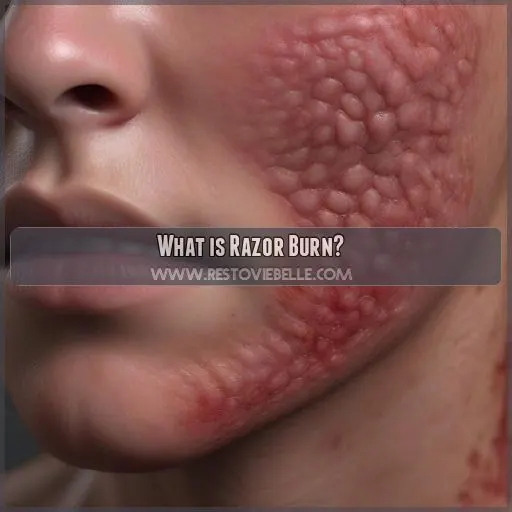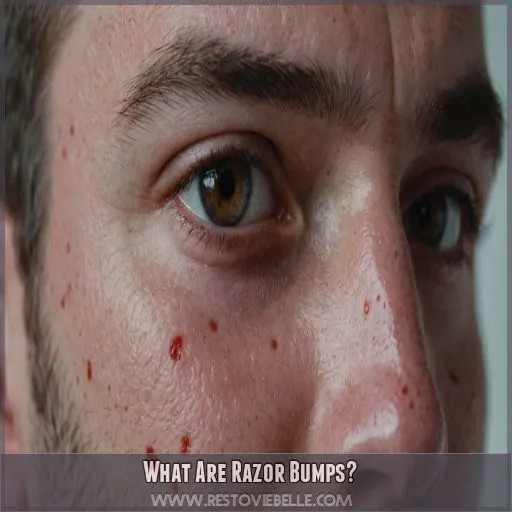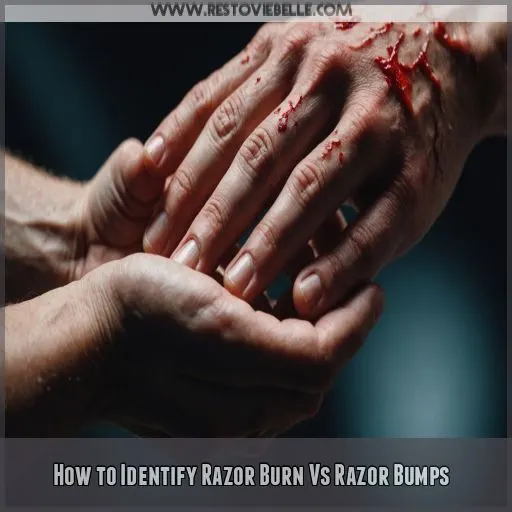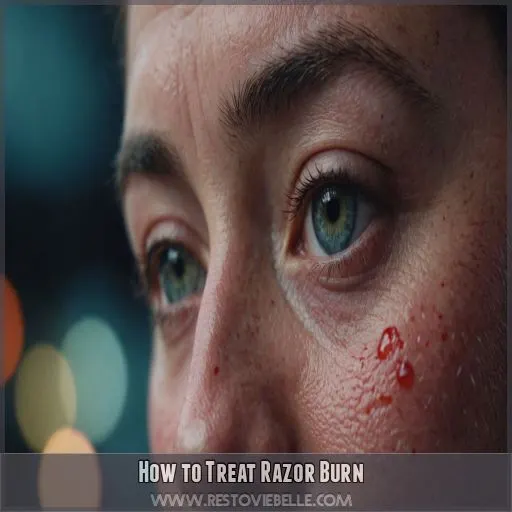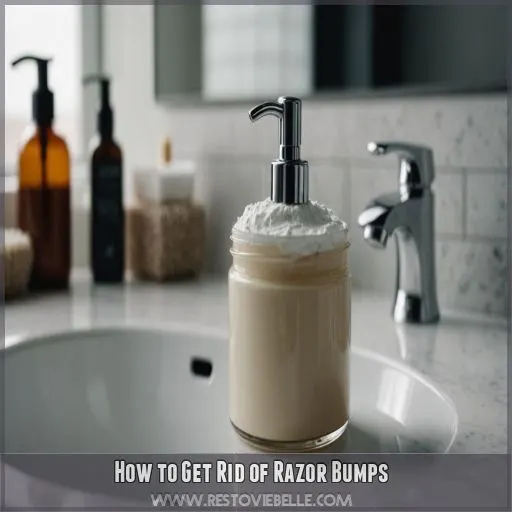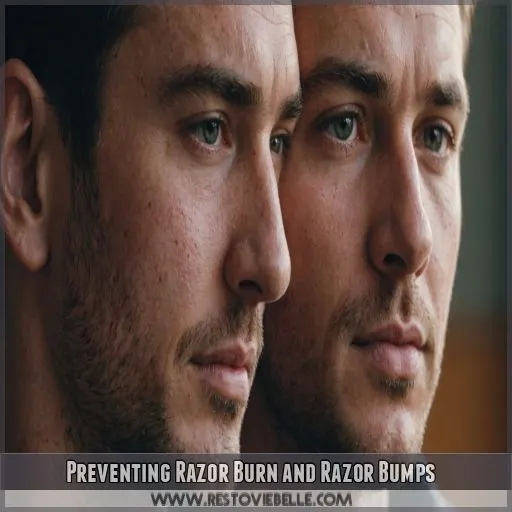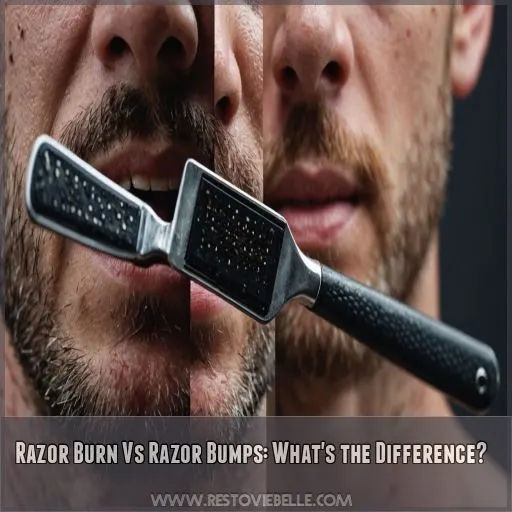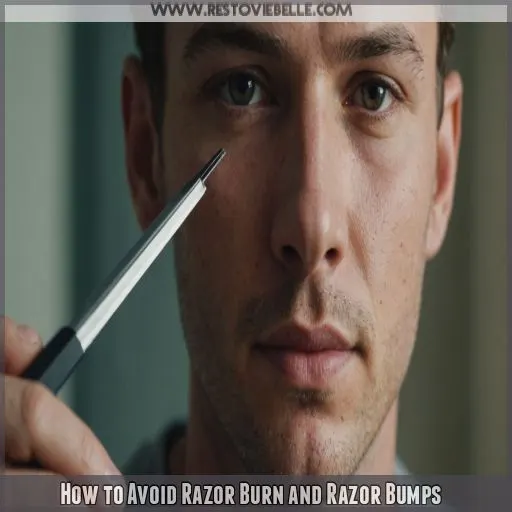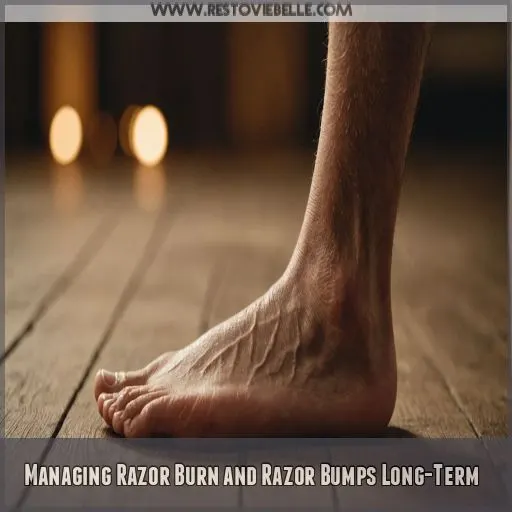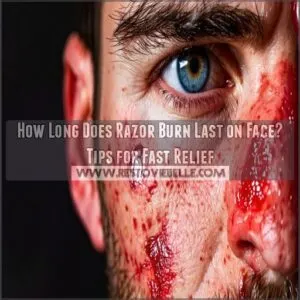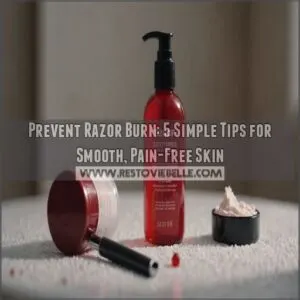This site is supported by our readers. We may earn a commission, at no cost to you, if you purchase through links.
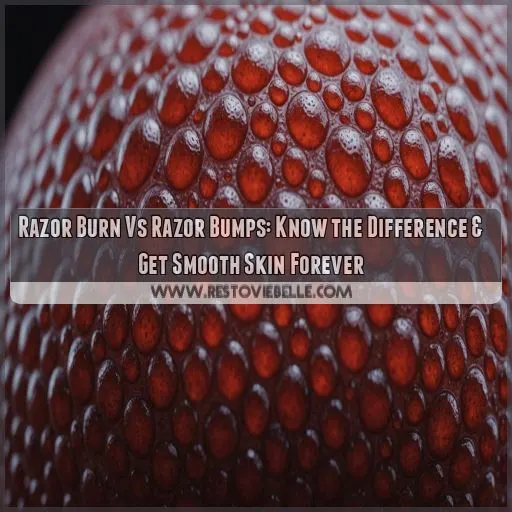 You’re probably wondering what the difference is between razor bumps and razor burn.
You’re probably wondering what the difference is between razor bumps and razor burn.
Razor burn is like a red, itchy blanket on your skin, usually caused by dull blades, dry shaving, or poor technique.
Razor bumps, on the other hand, are like mini pimples – they’re ingrown hairs that curl back into your skin, causing redness, pain, and swelling.
The key difference? Razor burn is a smooth, patchy rash, while razor bumps are small, bumpy dots.
Knowing the difference can help you tackle the right treatment and prevent these skin irritations for good.
Table Of Contents
- Key Takeaways
- What is Razor Burn?
- What Are Razor Bumps?
- How to Identify Razor Burn Vs Razor Bumps
- How to Treat Razor Burn
- How to Get Rid of Razor Bumps
- Preventing Razor Burn and Razor Bumps
- Razor Burn Vs Razor Bumps: What’s the Difference?
- How to Avoid Razor Burn and Razor Bumps
- Razor Burn and Razor Bumps on Sensitive Areas
- Managing Razor Burn and Razor Bumps Long-Term
- Frequently Asked Questions (FAQs)
- What does a razor burn look like?
- How long does razor burn last?
- How to clear razor bumps?
- What do razor bumps look like on a private area?
- Can razor burn and razor bumps cause permanent scarring?
- How long does it take for razor burn to heal?
- Can razor burn and razor bumps be a sign of skin infection?
- Are razor burn and razor bumps more common in certain skin types?
- Can razor burn and razor bumps be treated with home remedies?
- Conclusion
Key Takeaways
- You’re dealing with two different issues: Razor burn is like an angry red blanket on your skin, while razor bumps are more like a field of tiny, irritated volcanoes. Knowing which one you’re battling is half the battle!
- Your shaving technique can make or break your skin: Whether you’re shaving against the grain or using a dull blade, poor shaving habits are like inviting trouble over for dinner. Mastering your technique will put you on the path to smoother skin.
- Prevention is your new best friend: From exfoliating to choosing the right razor, a little preparation goes a long way. Think of it as laying out the red carpet for your skin – it will thank you later!
- Don’t suffer in silence: If your razor burn or bumps persist, it’s time to consult a professional. A dermatologist can be your skin’s superhero when home remedies aren’t effective.
What is Razor Burn?
You’ve probably experienced the pesky redness and itchiness that follows a shave – that’s razor burn, a cosmetic skin condition that occurs when your skin gets irritated from shaving.
Razor burn can happen to anyone who shaves, regardless of where you’re shaving.
Its symptoms include itchiness, a burning sensation, and redness, making it a form of irritant contact dermatitis that’s easy to diagnose but can be tricky to treat.
Symptoms of Razor Burn
The dreaded razor burn! You know, that pesky redness, itching, and burning sensation that can ruin your day. Add some stinging and tenderness to the mix, and you’re in for a real treat. Don’t worry, friend, you’re not alone. Razor burn is a common skin irritation that’s easily treatable.
Causes of Razor Burn
You know the feeling – you shave, and suddenly your skin is on fire! The main culprits behind razor burn are dull blades, dry shaving, and poor shaving technique. Add tight clothes to the mix, and you’ve got a recipe for skin irritation. Using shaving cream and a sharp razor can be total game-changers.
Risk Factors for Razor Burn
You’re more likely to get razor burn if you’re guilty of these common mistakes:
- Dry shaving: skipping the shaving cream or gel.
- Using dull blades that pull on your skin.
- Having a wonky shaving technique that causes friction.
- Ignoring your sensitive skin or skin type when shaving.
What Are Razor Bumps?
You’ve probably experienced those pesky red bumps after shaving, but did you know they’re actually a separate condition from razor burn? Razor bumps are essentially ingrown hairs that curl back into your skin and grow under the surface, causing red or skin-colored, pimple-like bumps that can be painful and uncomfortable.
Symptoms of Razor Bumps
You’ve got razor bumps – those pesky, painful bumps that appear after shaving. Symptoms include redness, itchiness, and inflammation. Ingrown hairs are the culprits, curling back into the skin and growing under the surface. You may experience pain, swelling, and pus-filled bumps. Ouch! Time to take action and soothe that skin!
Causes of Razor Bumps
You’re now dealing with razor bumps, those pesky, inflamed bumps that appear after shaving. Causes include shaving too closely, using a dull blade, or shaving against your hair type. Skin irritation and ingrown hairs are also culprits. Mastering your shaving technique and using a sharp blade can help prevent these unwanted visitors.
Difference Between Razor Bumps and Ingrown Hairs
You might be wondering, what’s the difference between razor bumps and ingrown hairs? While both can be painful and frustrating, razor bumps occur when hair grows back into the skin, causing redness and inflammation. Ingrown hairs, on the other hand, are individual hairs that curl back into the skin, causing a bump.
How to Identify Razor Burn Vs Razor Bumps
You’re probably all too familiar with the pesky redness and bumps that can appear after shaving, but do you know the difference between razor burn and razor bumps? Let’s break it down so you can identify what’s going on with your skin and take the right steps to soothe and prevent these annoying issues.
Visual Differences Between Razor Burn and Razor Bumps
- Color: Razor burn is typically red or pink, while razor bumps are more skin-toned or darker.
- Texture: Razor burn is smooth to the touch, whereas razor bumps are, well, bumpy.
- Shape: Razor burn is often patchy, while razor bumps are small, pimple-like dots.
- Severity: Razor burn can be mild or severe, but razor bumps can be super painful and inflamed.
Common Areas Affected by Razor Burn and Razor Bumps
When it comes to razor burn and razor bumps, some areas are more prone to irritation than others. Here are the most common areas affected:
| Area | Razor Burn | Razor Bumps |
|---|---|---|
| Legs | Redness, itchiness | Ingrown hairs, bumps |
| Underarms | Irritation, redness | Ingrown hairs, dark spots |
| Pubic Area | Itchiness, redness | Ingrown hairs, razor bumps |
These areas tend to be more sensitive, making them more susceptible to razor burn and razor bumps. By taking extra care when shaving these areas, you can reduce your risk of irritation.
How to Treat Razor Burn
You’ve fallen victim to razor burn, and now you’re wondering how to soothe that inflamed skin – don’t worry, we’ll help you out! From home remedies like Aloe Vera and cool compresses to over-the-counter treatments and knowing when to see a doctor, we’ll guide you through the best ways to treat razor burn and get your smooth skin back.
Home Remedies for Razor Burn
Time to soothe that razor burn! Try these home remedies:
- Aloe vera: Nature’s cooling gel to calm the burn.
- Cold compress: Chill out with a cold, damp cloth.
- Oatmeal bath: Soak in a warm, oatmeal-infused bath for relief.
- Tea tree oil: Mix a few drops with a carrier oil to reduce inflammation.
Over-the-Counter Treatments for Razor Burn
Now that we’ve covered home remedies, let’s explore over-the-counter treatments for razor burn. Look for creams with aloe vera (Source) or hydrocortisone , which can help soothe and reduce inflammation. Topical remedies like colloidal oatmeal can also provide relief. Always follow the product’s instructions and start with a small patch test.
When to See a Doctor for Razor Burn
If your razor burn is severe, doesn’t improve with home remedies, or shows signs of infection, it’s time to see a doctor. Don’t hesitate to seek professional help if you experience:
- Increasing redness or swelling
- Pus or discharge
- A foul odor
- Persistent itching or burning
- Delayed healing
How to Get Rid of Razor Bumps
You’re probably no stranger to the pesky red bumps that can appear after shaving, but did you know that razor burn and razor bumps are two distinct issues? Let’s explore how to get rid of razor bumps, those annoying ingrown hairs that can leave your skin feeling irritated and inflamed (Source).
Exfoliating to Prevent Razor Bumps
Hey there, friend! Want to say goodbye to those pesky razor bumps? Exfoliating is the way to go! Use a gentle scrub or loofah 2-3 times a week to remove dead skin cells and help ingrown hairs break through. Choose an exfoliating tool that suits your skin type and don’t overdo it.
| Skin Type | Exfoliating Tool | Scrub Type | Exfoliate Frequency |
|---|---|---|---|
| Normal | Loofah | Gentle | 2-3 times/week |
| Sensitive | Soft cloth | Fragrance-free | 1-2 times/week |
| Dry | Exfoliating gloves | Moisturizing | 1-2 times/week |
| Oily | Konjac sponge | Salicylic acid | 2-3 times/week |
Using Warm Compresses to Treat Razor Bumps
To treat razor bumps, give warm compresses a try!
Soak a clean cloth in warm water, wring it out, and apply it to the affected area for 5-7 minutes, 2-3 times a day.
This helps bring the ingrown hair to the surface, reducing inflammation and promoting healing.
Use a soft, breathable material like cotton, and avoid using hot water, which can irritate the skin.
Preventing Razor Burn and Razor Bumps
To prevent razor burn and razor bumps, you’ll want to master the art of shaving with finesse, using techniques like shaving in the direction of hair growth and choosing the right razor and shaving cream. By tweaking your shaving routine and selecting the right tools, you can minimize the risk of irritation and enjoy smooth, bump-free skin. (Source)
Shaving Techniques to Prevent Razor Burn and Razor Bumps
To prevent razor burn and bumps, start with a solid pre-shave prep: exfoliate your skin to remove dead cells and help hairs stand upright.
This will help your razor glide smoothly and prevent ingrown hairs.
When shaving, go with the grain – always shave in the direction of hair growth, not against it.
Using a sharp blade will minimize friction and irritation.
Finish with a gentle aftercare routine, including a soothing moisturizer to calm and hydrate your skin.
Your skin will thank you for the TLC!
Choosing the Right Razor and Shaving Cream
Now that you’ve got your shaving technique down, it’s time to choose the right tools for the job!
Pick a razor with a sharp blade that’s designed for your skin type.
For sensitive skin, opt for a single-blade or electric razor.
When looking for shaving cream, look for ingredients like aloe vera or coconut oil that’ll help soothe and moisturize your skin.
Don’t break the bank – there are plenty of budget-friendly options that’ll get the job done!
Razor Burn Vs Razor Bumps: What’s the Difference?
You’ve likely experienced the pesky duo of razor burn and razor bumps at some point in your shaving journey, but do you know the difference between these two unwanted skin guests? Understanding the distinct causes, symptoms, and treatment options for each will help you say goodbye to irritated skin and hello to a smoother, healthier you.
Understanding the Causes of Razor Burn and Razor Bumps
Let’s get real about razor burn and razor bumps. You’re likely causing them with dry shaving, dull blades, or skipping shaving cream. Exfoliating before shaving can help, but shaving against hair growth is a major culprit. Knowing the causes is key to prevention, so take control and adjust your shaving game!
Identifying the Symptoms of Razor Burn and Razor Bumps
If you’re dealing with razor burn and razor bumps, knowing the symptoms is key. Look for redness, itchiness, and skin irritation with razor burn, usually on your legs, underarms, or pubic area. Razor bumps, on the other hand, are ingrown hairs causing bumps, often with pain and swelling.
Treatment Options for Razor Burn and Razor Bumps
You’re dealing with razor burn or razor bumps – don’t worry, there are ways to help. Here are your treatment options:
- Home treatments: Apply aloe vera, tea tree oil, or a cold compress to soothe the skin.
- OTC options: Try hydrocortisone cream or razor burn creams.
- Doctor visits: If symptoms persist, consult a doctor for further guidance.
- Long-term care: Exfoliate regularly and maintain a consistent skincare routine.
How to Avoid Razor Burn and Razor Bumps
You’re one step closer to saying goodbye to those pesky razor burns and bumps. By incorporating a few simple tweaks into your pre- and post-shaving routine, you can enjoy silky smooth skin without the annoying irritation that often comes with it.
Pre-Shaving Routine to Prevent Razor Burn and Razor Bumps
Before you even pick up that razor, let’s get your skin ready for a smooth shave.
Exfoliate your skin 1-2 days prior to remove dead skin cells and help prevent ingrown hairs.
Take a hot shower to soften your hair, making it easier to shave.
Always shave in the direction of hair growth, not against it.
Choose a razor that’s right for your skin type and hair coarseness.
Moisturize your skin to keep it hydrated and supple.
Post-Shaving Routine to Prevent Razor Burn and Razor Bumps
After shaving, take a few seconds to give your skin some TLC.
Apply a moisturizing lotion or oil to lock in hydration and soothe any irritation.
You can also use a cooling gel or aftershave balm to calm the skin.
Exfoliate gently 1-2 times a week to prevent ingrown hairs and razor bumps.
Be gentle, and your skin will thank you!
Razor Burn and Razor Bumps on Sensitive Areas
Sensitive areas like the pubic area, bikini line, and underarms require extra TLC when shaving.
To avoid razor burn and bumps, use a gentle shaving cream and a sharp razor specifically designed for sensitive skin.
Exfoliate before shaving to prevent ingrown hairs.
Shave in the direction of hair growth, and avoid applying too much pressure.
Your sensitive skin will thank you for the extra care and attention.
Managing Razor Burn and Razor Bumps Long-Term
You’ve conquered the basics of razor burn and razor bumps – now it’s time to think long-term! To keep your skin smooth and happy, incorporate these habits into your daily routine:
- Exfoliate once or twice a week to remove dead skin cells and prevent ingrown hairs
- Upgrade your shaving tools every 1-3 months to avoid dull blades and bacteria buildup
- Make lifestyle changes like wearing loose clothing and using gentle skincare products to reduce irritation and friction.
Frequently Asked Questions (FAQs)
What does a razor burn look like?
Imagine you just shaved your legs for a beach day, but now they’re a lovely shade of lobster red. A razor burn looks like red, irritated skin with a streaky or blotchy rash that itches, stings, or feels tender.
How long does razor burn last?
Razor burn usually clears up on its own within a few days, but with proper care, you can speed up the healing process. You can expect it to last anywhere from a few hours to three days .
How to clear razor bumps?
To clear razor bumps, try gently exfoliating with a warm towel, then apply a soothing lotion or oil to calm the skin. Don’t pick or scratch – this can lead to infection and longer healing times!
What do razor bumps look like on a private area?
You’ve heard the whispers, but what’s the real deal? In your private area, razor bumps look like small, red, pimple-like bumps. They’re often itchy and can be painful. Don’t worry, though – they’re common and treatable.
Can razor burn and razor bumps cause permanent scarring?
You’re in luck! Razor burn and bumps usually don’t cause permanent scarring. They’re temporary nuisances that’ll fade with proper care. However, if you’re constantly battling these razor woes, it’s time to shake up your shaving routine!
How long does it take for razor burn to heal?
You’ll typically see razor burn fade in 2-3 days. Speed up healing by keeping the area clean, moisturized, and irritation-free. Remember, everyone’s skin is different – your mileage may vary! Patience is key.
Can razor burn and razor bumps be a sign of skin infection?
While you might think razor burn and bumps are just annoying, they can sometimes signal infection. You’ll notice unusual redness, swelling, or pus. Don’t panic though! Most cases aren’t serious, but if symptoms persist, it’s best to consult a doctor.
Are razor burn and razor bumps more common in certain skin types?
Yes, razor burn and bumps can be more common if you’ve got sensitive or coarse hair. Your skin type plays a role too – oily or dry skin might make you more prone to these pesky post-shave problems.
Can razor burn and razor bumps be treated with home remedies?
Ever wondered if your kitchen holds the cure for shaving woes? You’re in luck! You can treat razor burn and bumps with home remedies. Try aloe vera, tea tree oil, or a cool compress for soothing relief.
Conclusion
Knowing the difference between razor bumps and razor burn can be your ticket to smoother, happier skin.
Armed with this knowledge, you’re now equipped to tackle these pesky problems head-on.
If issues persist, don’t hesitate to seek professional help.
With a little patience and care, you’ll be flaunting silky-smooth skin in no time.

